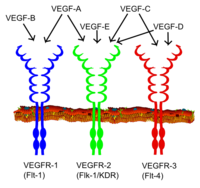
Photo from wikipedia
Background: Protein tyrosine phosphatase, non-receptor type 22 gene, which translates to lymphoid tyrosine phosphatase, is considered to be a susceptibility gene marker associated with several autoimmune diseases. Several studies have… Click to show full abstract
Background: Protein tyrosine phosphatase, non-receptor type 22 gene, which translates to lymphoid tyrosine phosphatase, is considered to be a susceptibility gene marker associated with several autoimmune diseases. Several studies have demonstrated the association of protein tyrosine phosphatase, non-receptor type 22 +1858C→T polymorphism with vitiligo. However, these studies showed conflicting results. Meta-analysis of the same was conducted earlier that included fewer number of publications in their study. Aim: We performed a meta-analysis of a total of seven studies consisting of 2094 cases and 3613 controls to evaluate the possible association of protein tyrosine phosphatase, non-receptor type 22 +1858C>T polymorphism with vitiligo susceptibility. Methods: We conducted a literature search in PubMed, Google Scholar and Dogpile for all published paper on protein tyrosine phosphatase, non-receptor type 22 +1858C→T polymorphism and vitiligo risk till June 2016. Data analysis was performed by RevMan 5.3 and comprehensive meta-analysis v3.0 software. Results: Meta-analysis showed an overall significant association of protein tyrosine phosphatase, non- receptor type 22 +1858C→T polymorphism with vitiligo in all models (allelic model [T vs. C]: odds ratio = 1.50, 95% confidence interval [1.32–1.71], P< 0.001; dominant model [TT + CT vs. CC]: odds ratio = 1.61, 95% confidence interval [1.16–2.24], P = 0.004; recessive model [TT vs. CT + CC]: odds ratio = 4.82, 95% confidence interval [1.11–20.92], P = 0.04; homozygous model [TT vs. CC]: odds ratio = 5.34, 95% confidence interval [1.23–23.24], P = 0.03; co-dominant model [CT vs. CC]: odds ratio = 1.52, 95% confidence interval [1.09–2.13], P = 0.01). No publication bias was detected in the funnel plot study. Limitations: Limited ethnic-based studies, unable to satisfy data by gender or vitiligo-type are some limitations of the present meta-analysis. Conclusion: Stratifying data by ethnicity showed an association of protein tyrosine phosphatase, non-receptor type 22 +1858C→T with vitiligo in European population (odds ratio = 1.53, 95% confidence interval [1.34–1.75], P< 0.001) but not in Asian population (odds ratio = 0.59, 95% confidence interval [0.26–1.32], P = 0.2). In conclusion, protein tyrosine phosphatase, non-receptor type 22 +1858 T allele predisposes European individuals to vitiligo.
Journal Title: Indian Journal of Dermatology, Venereology and Leprology
Year Published: 2017
Link to full text (if available)
Share on Social Media: Sign Up to like & get
recommendations!